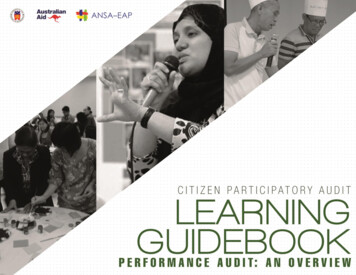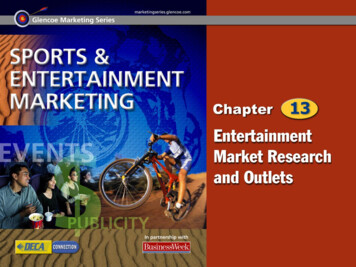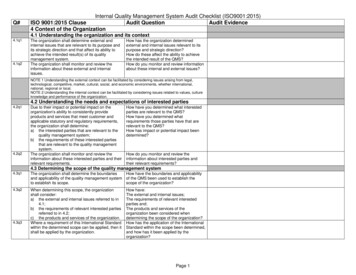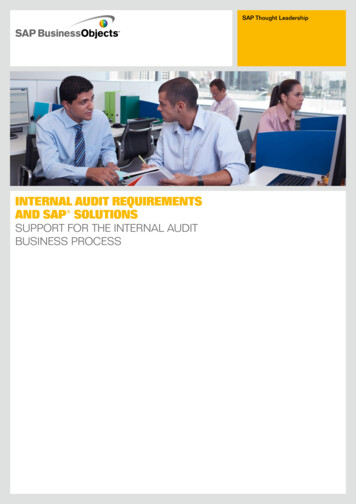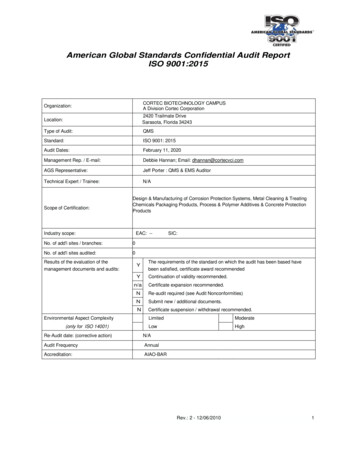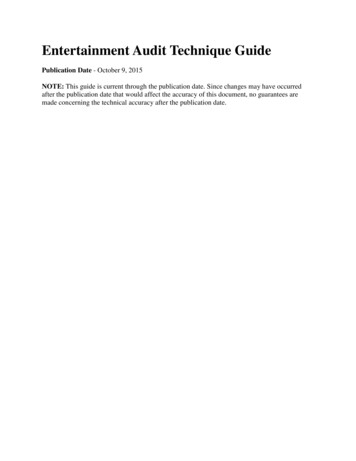
Transcription
Entertainment Audit Technique GuidePublication Date - October 9, 2015NOTE: This guide is current through the publication date. Since changes may have occurredafter the publication date that would affect the accuracy of this document, no guarantees aremade concerning the technical accuracy after the publication date.
Table of ContentsEntertainment Audit Technique Guide . 1Introduction. 5Chapter 1 - Background . 5Overview. 5Chapter 2 - Planning the Audit . 8General Approach to the Interview . 8Self-Employment Tax Considerations . 10Employee Versus Independent Contractor . 10Audit Techniques . 10Non-Filers . 11Chapter 3 - Income Issues . 12Residuals . 12Royalties and License Fees . 12Fringe Benefits. 12Advances. 13Reconstruction of Income . 14Chapter 4 - Capitalization and Cost Recovery Issues . 15Capitalization Issues . 15Cost Recovery Issues . 19Exhibit 4-1 - Decision Path for Capitalization. 25Chapter 5 - Passive Activity Issues. 26I.R.C. §469 . 26Rental of Equipment . 27Royalty Income . 28Other Activities . 29Conclusion . 31Chapter 6 - Travel and Transportation Issues . 31General . 31Travel . 31Transportation . 33Chapter 7 - Recordkeeping Issues. 35Meals, Entertainment, and Gifts . 35Educational and Research Expenses . 35
Telecommunication Expense . 37Chapter 8 - Personal Expense Issues . 37Keeping Current. 37Court Cases . 39Chapter 9 - Other Issues. 40Office In The Home . 40Activities Not Engaged In For Profit . 43Job Search . 43Showcasing . 44Agents . 44Moving Expenses. 45Personal Service Companies and Personal Holding Companies . 46Chapter 10 - Music Business . 47Overview. 47General Information . 48Digital Music . 50Downloads . 51General Questionnaire . 53Music Industry Research and Publications . 53Music Industry Organizations. 55Chapter 11 - Songwriters . 58General Information . 58Recordkeeping . 59Examination Plan . 59Audit Issues. 60Songwriters Questionnaire. 61Chapter 12 - Publishers . 62General Information . 62Recordkeeping . 63Examination Plan . 63Audit Issues. 63Publishers Questionnaire . 64Chapter 13 - Live Performers . 65General Information . 65
Stars. 65Other Performers. 66Recordkeeping . 66Examination Plan . 67Audit Issues. 67Live Performers Questionnaire . 68Employment Tax Questions:. 69Chapter 14 - Producers. 69General Information . 69Recordkeeping . 71Examination Plan . 71Audit Issues. 71Producers Questionnaire . 73Chapter 15 - Managers. 74General Information . 74Recordkeeping . 75Examination Plan . 75Audit Issues. 76Management Questionnaire . 76Chapter 16 -Videos . 77General Information . 77Recordkeeping . 77Examination Plan . 78Audit Issues. 78Videos Questionnaire. 78Chapter 17 - Employment Tax. 79General Information . 79Employees – Household Employees. 81Chapter 18 - Reference Material . 82Abbreviations . 82General Terms. 83Music Terms . 85Overview of Common Issues in the Entertainment Industry . 89
IntroductionThe purpose of this Entertainment Audit Technique Guide (ATG) is: To provide an overview of the activities encountered in examinations of individuals inthe entertainment industry.To familiarize examiners with issues and terminology pertinent to individuals in theentertainment industry.To assist examiners with their examinations by providing audit techniques.This ATG should help reduce the time needed to examine returns of individuals in theentertainment industry by providing some background on the industry and the applicable tax law.While this guide covers a variety of situations and issues, it is not all-inclusive.Chapter 1 - BackgroundOverviewThis audit technique guide is designed to provide assistance in auditing individuals in variousaspects of the entertainment industry. The issues need to be developed in relation to thetaxpayer's trade or business. Sometimes it is a challenge to determine the exact nature of thetaxpayer's profession. It is, therefore, necessary to look beyond the job title and determine theactual duties and responsibilities of the taxpayer.At one time, an individual's job title clearly denoted the duties associated. Now, there is a greatdeal of crossover between job titles. In the early years of film making, the director was under thecontrol of the producer and had complete control of the actors, editors, etc. Now, many actorshave creative control. Directors may have creative control. Editors may work directly under thecontrol of the producer and independent of the director.Individuals can function in different job titles on different projects. A taxpayer may be a propertymaster on one project and a "prop man," assistant property master, or a set dresser on another.Many actors are also directors or producers, sometimes on the same project. It is, therefore,critical to determine the duties of a taxpayer in regard to each project. This will be important indetermining which expenses are ordinary and necessary.In the film industry, employees are categorized as "above the line" or "below the line." Abovethe line employees are thought of as creative talent, while below the line generally refers totechnicians and support services (although it includes set designers and artists). The "line" is anaccounting demarcation used in developing the budget for production. Some above the line costsare incurred even before a film goes into the production stage. Above the line costs include thestory rights, the screen play, the producer, the director, and the principal cast. Generally, duringthe "pre-production" period, the expense for the principal cast is negotiated, but the cost of thestory rights are actually paid.
This audit technique guide covers performers, producers, directors, technicians, and otherworkers in the film industry, the recording industry, and live performances. The same generalrules apply and the same issues are found on most of these returns. While working in theentertainment industry, taxpayers are involved in performing for compensation, searching forwork through auditions or any other reasonable means of attaining employment, or maintainingtheir position (skills, image, etc.) through reasonable expenditures for education, training, publicrelations, etc.Historically, taxpayers in the entertainment industry tend to be aggressive or abusive whendeducting expenses that may or may not be related directly to their business activities (i.e.,personal expenses). Our goal is to bring the allowable deductions back within the confines of theCode. The distinction between ordinary/necessary and extravagant must be more clearly drawn.Unions and GuildsThe entertainment industry has numerous unions and guilds. Each of these organizations hasentered into a collective bargaining agreement on behalf of its members. These agreements orcontracts address rates of compensation, reimbursements, allowances, hours required to beworked, materials to be provided, etc. Prominent performers and creative talents may negotiateadditional terms for each project on which they work to supplement the union or guild contract(or have their attorney or business manager negotiate these items). Issues not addressed in theseindividual contracts are determined on the basis of the underlying union or guild contract.When an individual is a member of a guild or union (i.e., pays dues), we can generally assumethat individual is entitled to the benefits of the union/guild contract for the year(s) underexamination. In the absence of any verification to the contrary, all reimbursements and benefitsprovided for in the contract will be deemed available to the taxpayer.ReimbursementsWhen entertainment industry taxpayers work on union productions, their respective contractstypically require allowances or reimbursement compensation. Taxpayers claiming otherwiseshould prove they were not entitled to allowances, reimbursements, or compensation under theirapplicable contract. The major unions (SAG, DGA, etc.) have contracts that provide forextensive reimbursement and compensation for the more common expenses such as travel andmeals. Many other expenses commonly seen are covered by the contracts as well (e.g., physicaltrainers; offices; security; travel and related expenses for spouses, significant others, children;etc.).Taxpayers who claim a production was non-union must provide a copy of their contract with theproducer or other proof.Frequently, taxpayers claim that although expenses were reimbursable under the contract, theydid not claim reimbursement because they feared they might not be hired for future projects. TheIRS position is, nevertheless, that if the taxpayer could have received reimbursement, the
expense is not deductible even if the reimbursement is not claimed. See Kennelly v.Commissioner, 56 T.C. 936, 943 (1971), aff'd, 456 F.2d 1335 (2d Cir. 1972).If the expense exceeds the potential reimbursement, the excess expense may be allowable if it isnecessary. The most common example is the auto expense. If the taxpayer claims actualexpenses, the expense can be reduced by the mileage reimbursement available (whether or notclaimed from the employer) and the remainder may still be allowed as a deduction.When the taxpayer is entitled to stay in a hotel that would be paid for by the employer butchooses to stay at another hotel at his own expense, the excess expense is not considerednecessary. Personal preference is not a valid business reason to incur an otherwise unnecessaryexpense.See Chapter 3, section titled Fringe Benefits, for information on I.R.C. § 62(c) whenreimbursement can create income.CopyrightsAn implied copyright is automatically created as soon as a copyrightable item is created. Thisprotects the creative talent from having his or her work stolen. This applies to screenplays,scripts, compositions, etc. Additionally, finished works are generally protected by a formalcopyright. The following materials may be copyrighted: Literary worksMusical works, including any accompanying wordsDramatic works, including any accompanying musicPictorial and graphic worksMotion pictures and other audiovisual worksSound recordingsAn idea or concept cannot be copyrighted. The copyright covers the artistic interpretation orspecific treatment of the concept.Period CoveredAny copyright, the first term of which was in existence prior to January 1, 1978, endures for 28years from the date it was originally secured. Copyrights registered before January 1, 1978 canbe renewed to endure for 95 years from the date the copyright was originally secured. In general,a copyright on a work created on or after January 1, 1978, lasts for the life of the author and 70years after the author's death (with no renewal), or 120 years for corporate authorship.Copyright InfringementThe use of copyrighted material without permission is an infringement of the owner's copyright.The copyright is an exclusive right which covers copying, reproducing, printing, reprinting, andpublishing copyrighted works. It also covers the use of copyrighted material in audiovisuals.
Receiving IncomeWhen copyrighted material is used, reproduced, or adapted to another medium, permission mustbe obtained. This generally results in royalties being paid to the copyright holder, fees being paidfor the granting of a license, or the selling of an option. This income to the copyright holder istaxable. Royalty income is not passive per I.R.C. § 469(e)(1)(A).If the taxpayer was regularly engaged in the trade or business that generated the royalty, whenreceived by the taxpayer, the income is considered self-employment income and is subject toself-employment tax. See Treas. Reg. § 1.1402(a)-1(c); Rev. Rul. 68-498, 1968-2 C.B. 377(discussing a writer who wrote many books and hence qualified to pay self-employment tax).Revising prior editions of a work one had created could also be sufficient to constitute a trade orbusiness and the income would therefore be subject to self-employment tax. See Langford v.Commissioner, T.C. Memo. 1988-300, aff'd, 881 F.2d 1076 (6th Cir. 1989).However, if the taxpayer was not engaged regularly in the trade or business that generated theroyalty, then it is not subject to self-employment tax. See Langford v. Commissioner, T.C.Memo. 1988-300, aff'd, 881 F.2d 1076 (6th Cir. 1989). For example, "[i]f an individual writesonly one book as a sideline and never revises it, he would not be considered to be 'regularlyengaged' in an occupation or profession and his royalties therefrom would not be considered netearnings from self-employment." Rev. Rul. 68-498, 1968-2 C.B. 377.The payer has an expense for the purchase of the option, fees for the granting of a license, or thepayment of royalties. This expense would typically be subject to capitalization as a productionexpense.Chapter 2 - Planning the AuditGeneral Approach to the InterviewThe key to a successful audit, particularly with individuals in the entertainment industry, isdeveloping a solid background and history of the individual's activities and responsibilities.Because people in this industry slide from one job category to another, it is imperative todetermine what the taxpayer actually did to receive each item of compensation during the taxyear. If a "singer" received all of his or her income from choreographing another performer'sroutines, his or her expenses should not include any "on camera" costs such as wardrobe, makeup, or hair. He or she should, likewise, not be incurring expenses for rehearsal studios or back-upmusiciansInformation to ObtainWhenever possible, secure copies of all contracts, project agreements, deal memos, workingproposals, letters of understanding, etc. pertaining to the taxpayer's activities. This is importantwhether or not the income from these projects was received in the tax year. These agreementsprovide fundamental information on the nature of the taxpayer's income, expenses and
reimbursements. The contracts also disclose who has control and who retains any rights relatedto the project.Request a copy of the taxpayer's resume. This will show what type of work the taxpayer hasdone, what sources of income (royalties, residuals, etc.) to expect, and the taxpayer's reputationor standing in the industry. The examiner should research the taxpayer on the internet. Mostpeople in show business will list their credits and the examiner will be able to see some of theprojects in which the taxpayer participated. The following are some internet sites the examinercan use: IMDb.com and Freebase.com. The examiner can also see if the taxpayer has his or herown website. The taxpayer's standing in the industry can be helpful in determining the nature andextent of expenses that would be incurred to maintain that standing. An unknown actor wouldnot normally need to send gifts to a prominent producer. A well-known, highly sought aftersinger would not need to entertain a camera operator.Allocation of Personal ExpensesThe allocation between personal expenses and business purpose will depend on specificcorrelation between expenditure and income source. The background interview is very importantfor these cases. It will be the basis upon which expenses will be allowed.Get an initial chronological background of the tax year by inspecting or researching all logs andrecords of travel and meals and entertainment. Try using a general month to month format. Get asense of the taxpayer's main activities each month.Through oral testimony from the taxpayer or third party contacts, you can retrieve the datesworked, requirements, and specific activities as they correlate for each Form W-2, Form 1099MISC, etc.RecordkeepingIn the case of personal expenses used for business purposes, the taxpayer's compliance withI.R.C. § 274 determines the deductions allowed. Taxpayers who do not comply with thesubstantiation requirements of I.R.C. § 274(d) are not allowed very many, if any, deductions.The criteria for I.R.C. § 274(d) are the amount of such expense or other item; the time and placeof the travel, entertainment, amusement, recreation; the business purpose; and the businessrelationship to the taxpayer of persons entertained.No deduction should be allowed if the taxpayer is merely receiving a general business benefitfrom personal expenses, rather expenses must be directly related to income. The detailed rulesfor determining what requirements a taxpayer must meet for the entertainment to be directlyrelated can be found in Treas. Reg. 1.274-2(c).The documentation limitation under I.R.C. § 274(d) supersedes the Cohan doctrine (Cohan v.Commissioner, 39 F.2d 540 (2d Cir. 1930)), which states that when possible the court shouldmake a close approximation rather than disallow a deduction entirely.
If a taxpayer received both a Form W-2 and a Form 1099-MISC for income, determine what theForm 1099-MISC income is - that is, independent contractor, self-employment income, orreimbursement. Allow related expenses against this income. Allocate expenses betweenSchedule A and Schedule C when the taxpayer has both the Form W-2 and Form 1099-MISCincome in the same line of work. If the taxpayer cannot establish which expenses directly resultfrom each respective source of income, allocate the expenses as (W-2 entertainment incomedivided by total entertainment income) times allowable entertainment business expenses whichequals Schedule A miscellaneous employee business expense. This formula is also shown below:(W-2 Entertainment Income Total Entertainment Income) Allowable Entertainment BusinessExpenses Schedule A Miscellaneous "EBE"The balance of the entertainment business expenses may be allowed on Schedule C.Self-Employment Tax ConsiderationsNet profit from self-employment over 400 is subject to self-employment tax. Once expenseshave been properly allocated, insure that any net profit or loss is considered in determining thetaxpayer's net self-employment income. Remember to include income or losses frompartnerships and other self-employed activities. Residual payments that do not have FICAwithholding should be assessed self-employment tax if a net profit is realized after relatedexpenses, if any, are deducted.Royalties resulting from services performed (e.g., music performed, songs written, screenplaywritten, etc.) are subject to self-employment tax in the same manner as residuals. Royalties frommerchandising or licensing, which did not involve any services, are not subject to selfemployment tax.Employee Versus Independent ContractorThe majority of entertainers and technicians are employees and will receive a Form W-2 withfederal income tax and FICA tax withheld. The extent of control a studio or production companyhas over an entertainer continues to be the determining factor in classifying an individual aseither an employee or an independent contractor. Treas. Reg. § 31.3401(c)-1(b) states in part:Generally, the relationship of employer and employee exists when the person forwhom services are performed has the right to control and direct the individualwho performs the services, not only as to the result to be accomplished by thework but also as to the details and means by which that result is accomplished.Audit TechniquesWhen a taxpayer has received a Form W-2, but claims to actually be an independent contractor,be thorough in developing the facts. Consider the following factors:
The taxpayer receiv
Introduction. The purpose of this Entertainment Audit Technique Guide (ATG) is: To provide an overview of the activities encountered in examinations of individuals in the entertainment industry. To familiarize examiners with issues and terminology pertinent to individuals in the entertainment industry. To assi





